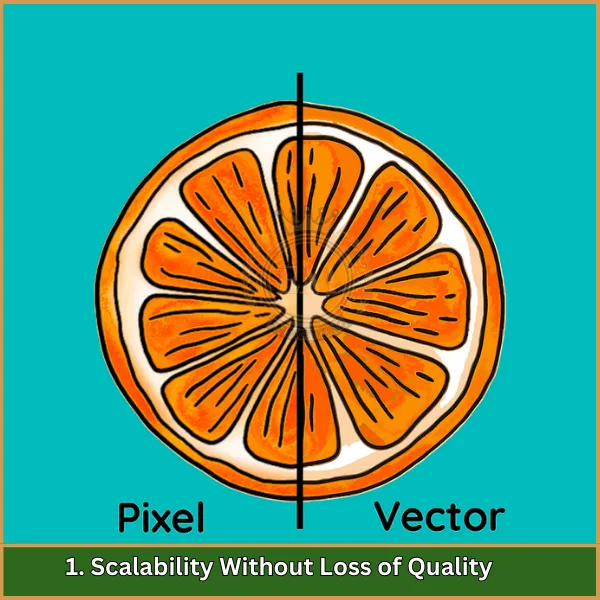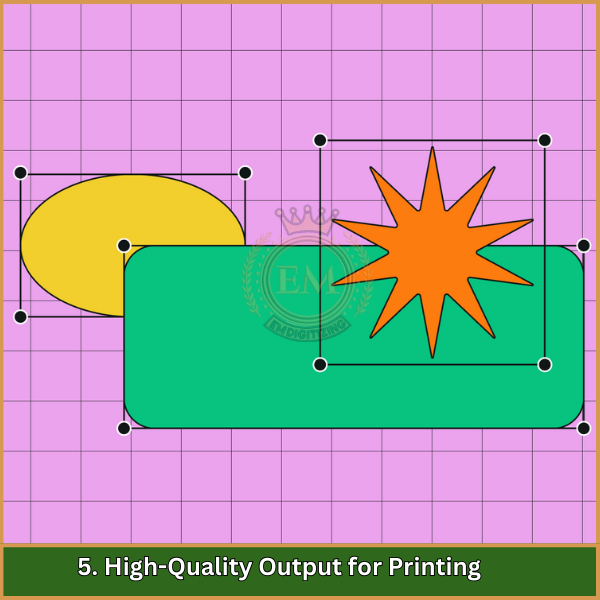Wenn es um Design geht, Das Kennen der Vor- und Nachteile von Vektorbildern kann einen großen Unterschied machen. Sie werden für ihre Fähigkeit geliebt, zu skalieren, ohne Klarheit zu verlieren, Damit eignen sie sich perfekt für Projekte wie Logos und Symbole.
Jedoch, Sie haben ihre Schattenseiten, zum Beispiel nicht ideal für detaillierte oder lebensechte Bilder. Zusätzlich, Das Erstellen und Bearbeiten von Vektordateien erfordert häufig spezielle Software und Fachkenntnisse.
In diesem Artikel, Wir untersuchen die Vor- und Nachteile vektorisierter Bilder, um Ihnen dabei zu helfen, herauszufinden, ob sie die richtige Wahl für Ihr nächstes Projekt sind.

Was sind die Vor- und Nachteile von Vektorbildern??
Vorteile von Vektorbildern
Die Vorteile der Verwendung Vektorbilder machen sie zu einer idealen Wahl für verschiedene Designprojekte, insbesondere dort, wo Skalierbarkeit und Klarheit unerlässlich sind.
- Skalierbarkeit ohne Qualitätsverlust
- Kleinere Dateigrößen
- Einfach zu bearbeiten und zu manipulieren
- Kompatibilität zwischen verschiedenen Plattformen
- Hochwertige Ausgabe zum Drucken
1. Skalierbarkeit ohne Qualitätsverlust

Ein großer Vorteil besteht darin, dass die Größe von Vektordateien ohne Qualitätsverlust stufenlos geändert werden kann. Ob das Design für eine Werbetafel vergrößert oder für eine Visitenkarte verkleinert wird, es bleibt klar und deutlich. Dadurch sind sie ideal für Logos und andere Designs, die Flexibilität in der Größe erfordern.
2. Kleinere Dateigrößen
Vektordateien sind im Vergleich zu hochauflösenden Rasterbildern im Allgemeinen viel kleiner, da sie mathematische Formeln anstelle von Pixeln verwenden. Diese geringere Dateigröße erleichtert die Speicherung, Aktie, und schnell auf verschiedenen Plattformen und Geräten laden, Verbesserung der Arbeitsablaufeffizienz.
3. Einfach zu bearbeiten und zu manipulieren

Das Bearbeiten von Vektorgrafiken ist unkompliziert, as each component—whether it’;Es ist eine Form, Linie, oder Kurve – kann individuell angepasst werden, ohne das gesamte Design zu beeinflussen. Diese Flexibilität ermöglicht es Designern, schnelle Änderungen vorzunehmen, Dadurch werden Vektordateien zu einer praktischen Option für komplexe Projekte.
4. Kompatibilität zwischen verschiedenen Plattformen
Vektordateien sind mit den meisten Designprogrammen kompatibel, Ermöglicht eine einfache Übertragung und Zusammenarbeit zwischen verschiedenen Plattformen. Ob Sie mit Adobe Illustrator arbeiten, Coreldraw, oder ein anderes Programm, Die Datei wird reibungslos geöffnet, Dies macht es für Designer vielseitig einsetzbar.
5. Hochwertige Ausgabe zum Drucken

Wenn es ums Drucken geht, Vektorgrafiken liefern hochwertige Ergebnisse. Since they don’;t pixelig, Sie sorgen für Schärfe, Saubere Drucke für alles, von kleinen Etiketten bis hin zu großen Bannern, Gewährleistung eines professionellen und polierten Finishs.
Nachteile von Vektorbildern
Die Nachteile der Verwendung Vektorbilder sollte berücksichtigt werden, especially if you’;Ich arbeite an Designs, die viele Details oder Realismus erfordern.
- Begrenzte Details für komplexe Bilder
- Nicht ideal für fotorealistische Bilder
- Software- und Qualifikationsanforderungen
- Begrenzt durch Dateiformate
- Für bestimmte Designarten ineffizient
1. Begrenzte Details für komplexe Bilder
Sie eignen sich hervorragend für einfache Designs, Bei sehr detaillierten oder komplexen Bildern haben sie jedoch Probleme, wie Fotos oder komplizierte Kunstwerke. Da Vektoren aus Formen wie Linien und Kurven bestehen, they can’;Es werden keine feinen Details wie Schatten oder Texturen angezeigt, die Bilder rastern (aus Pixeln gemacht) leicht darstellen kann.
2. Nicht ideal für fotorealistische Bilder
Während Vektoren perfekt für Dinge wie Logos und Symbole geeignet sind, they aren’;Es ist nicht gut zum Gestalten fotorealistische Bilder. Vectors can’;Die Tiefe wird nicht reproduziert, Textur, oder das natürliche Aussehen eines echten Fotos. Wenn Sie ein lebensechtes Bild erstellen oder damit arbeiten müssen, Ein Rasterbildformat wie JPEG oder PNG ist die bessere Wahl.
3. Software- und Qualifikationsanforderungen

Für die Erstellung von Vektordateien ist eine spezielle Designsoftware erforderlich, wie Adobe Illustrator oder CorelDRAW. Diese Programme können teuer sein, und sie haben oft eine steile Lernkurve, was für Anfänger schwierig sein kann. Um diese Tools vollständig nutzen zu können, sind einige technische Fähigkeiten erforderlich, Dies könnte für Gelegenheitsnutzer oder kleine Unternehmen ein Hindernis darstellen.
4. Begrenzt durch Dateiformate
Obwohl Vektordateien sehr nützlich sind, they aren’;Wird nicht von jedem Programm oder jeder Plattform unterstützt. Formate wie SVG oder EPS sind mit einigen möglicherweise nicht vollständig kompatibel Design-Software oder Webbrowser. Das bedeutet, dass Sie sie möglicherweise in allgemein akzeptierte Formate konvertieren müssen, Dies kann manchmal die Qualität oder Funktionalität des Bildes beeinträchtigen.
5. Für bestimmte Designarten ineffizient
Sie sind nicht immer die beste Wahl für alle Designprojekte. Zum Beispiel, wenn Ihr Projekt viele komplizierte Designs beinhaltet, Farbverläufe, oder weiche Farbübergänge, Vektoren können ineffizient sein und möglicherweise nicht den gewünschten visuellen Effekt erzeugen. In solchen Fällen, Rasterbilder können diese Details effektiver und einfacher verarbeiten.
Letzte Worte
Um den richtigen Bildtyp für Ihr Design auszuwählen, ist es wichtig, die Vor- und Nachteile von Vektorbildern zu verstehen. Sie eignen sich perfekt zum Ändern der Größe ohne Qualitätsverlust, Für sehr detaillierte oder realistische Bilder sind sie jedoch möglicherweise nicht die beste Wahl.
Wenn Sie auf der Suche nach professionellen Vektorkunstdiensten sind, EMDigitalisierung ist hier, um zu helfen! Wir bieten schnellen Service, bezahlbare Preise, und hochwertige Designs, die Ihren Bedürfnissen entsprechen. Egal, ob es sich um ein Logo oder ein anderes Vektorprojekt handelt, Wir sind für Sie da. Plus, Genießen Sie ein besonderes Erlebnis 50% Rabatt für Erstkunden! Lassen Sie uns Ihre Ideen mit atemberaubenden Vektordesigns zum Leben erwecken.
Häufig gestellte Fragen
Sie werden hauptsächlich für Logos verwendet, Illustrationen, und Drucklayouts, da sie ohne Qualitätsverlust in der Größe geändert werden können, Damit eignen sie sich sowohl für kleine als auch große Formate.
Häufige Beispiele für Vektordateien sind Firmenlogos, Architekturpläne, und digitale Illustrationen, die in Software wie Adobe Illustrator erstellt wurden.
Die gängigsten Arten von Vektorgrafiken sind SVG (Skalierbare Vektorgrafiken), ENV (Gekapseltes PostScript), und PDF (Portables Dokumentenformat), die in verschiedenen digitalen und gedruckten Medien weit verbreitet sind.
